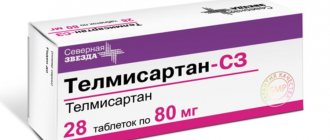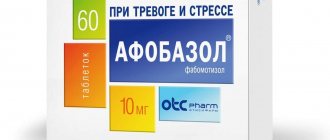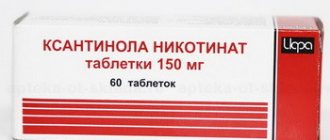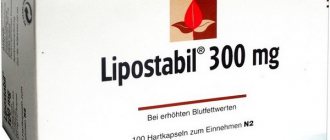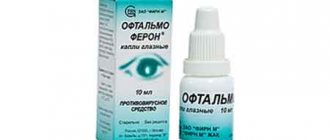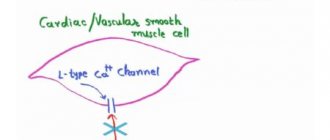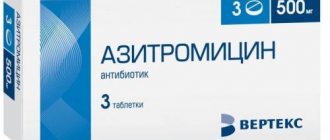Poor nutrition, a sedentary lifestyle, and problems with the digestive system lead to disorders of fat metabolism. Substances that, in excess, can cause irreparable harm to the body begin to accumulate. First of all, these are various types of fats - lipoproteins, cholesterol, triglycerides, and others. This phenomenon can be the beginning of a number of vascular diseases that threaten severe complications in the form of heart attacks and strokes.
In order to help our body in fat metabolism, there are drugs from the pharmaceutical industry, one of the prominent representatives of which is Traikor. Today we will look at the indications for the use of Traykor, its instructions for use, contraindications and possible adverse reactions.
Release form and composition
Traykor is available in the following dosage forms:
- film-coated tablets, 145 mg: oblong, white, with the company logo on one side of the tablet and the inscription “145” on the other (10 pieces in blisters, in cartons 1, 2, 3, 5, 9 or 10 blisters; 14 pieces in blisters, in a cardboard box of 2, 6 or 7 blisters; for hospitals - 10 pieces in blisters, in a cardboard box of 28 or 30 blisters);
- film-coated tablets, 160 mg: oblong, white, with the company logo on one side of the tablet and the inscription “160” on the other (10 pieces in blisters, in cartons 1, 2, 3, 4, 5, 9 or 10 blisters; 14 pcs. in blisters, in a cardboard package 2, 6 or 7 blisters).
Each pack also contains instructions for using Trikor.
Composition per film-coated tablet:
- active ingredient: fenofibrate (micronized in the form of nanoparticles) – 145 mg or 160 mg;
- auxiliary components: sodium lauryl sulfate, sodium stearyl fumarate, crospovidone, colloidal silicon dioxide, sodium docusate, sucrose, lactose monohydrate, microcrystalline cellulose, hypromellose, magnesium stearate, povidone;
- film shell: Opadry OY-B-28920 (titanium dioxide, talc, xanthan gum, polyvinyl alcohol, soy lecithin).
Pharmacological properties
Pharmacodynamics
Fenofibrate is a fibric acid derivative. The mechanism of its action is associated with the activation of PPAR-alpha (peroxisome proliferator-activated receptor alpha). Due to the activation of PPAR-alpha, lipolysis of atherogenic lipoproteins is enhanced and their removal from plasma is accelerated. It also leads to an increase in the synthesis of apoproteins A-1 and A-2 (Apo A-1 and Apo A-2). As a result of this action, the content of the LDL (low-density lipoprotein) and VLDL (very low-density lipoprotein) fractions decreases and the content of the HDL (high-density lipoproteins) fraction increases. Fenofibrate increases the rate of LDL excretion and reduces the content of small and dense LDL particles, an increase in the number of which is observed in patients with an atherogenic lipid phenotype (such disorders occur especially often in individuals at risk of coronary heart disease).
As a result of clinical studies, fenofibrate was shown to reduce the concentration of triglycerides by 40–55% and total cholesterol by 20–25% while increasing cholesterol and HDL cholesterol by 10–30%. In patients with hypercholesterolemia with reduced levels of cholesterol and LDL (by 20–35%), the following types of ratios are reduced during the use of fenofibrate: “LDL-cholesterol/HDL-cholesterol”, “total cholesterol/HDL-cholesterol”, “Apo B/Apo” A-1" (the listed ratios are markers of atherogenic risk).
Since Traykor significantly affects the level of triglycerides and LDL cholesterol, its use in hypercholesterolemia, accompanied and not accompanied by hypertriglyceridemia (including secondary hyperlipoproteinemia, for example, type 2 diabetes), is fully justified.
During the use of fenofibrate, a significant reduction and even complete disappearance of extravascular cholesterol deposits (tuberous and tendon xanthoma) is possible. In individuals with high levels of fibrinogen under the influence of fenofibrate, a significant decrease in this indicator is observed (as in patients with increased concentrations of lipoproteins). Levels of another inflammatory marker, C-reactive protein, also decrease with fenofibrate therapy.
Among other things, Traykor has a uricosuric effect and reduces the concentration of uric acid by approximately 25%, which is an additional benefit for patients with hyperuricemia and dyslipidemia.
In experiments conducted on animals, as well as during a clinical study of the drug, it was shown that it reduces platelet aggregation caused by epinephrine, arachidonic acid and adenosine diphosphate.
Pharmacokinetics
Trikor 160 mg tablets have higher bioavailability than earlier dosage forms of fenofibrate.
Maximum plasma concentration is achieved after 2–4 hours (145 mg tablets) or 4–5 hours (160 mg tablets). It does not depend on food intake and with long-term use of the drug remains stable, regardless of the individual characteristics of the patient.
After taking Traykor, the original fenofibrate is not detected in the blood plasma. It undergoes hydrolysis by esterases. The main plasma metabolite of the drug is fenofibric acid, more than 99% bound to plasma proteins (albumin). Fenofibrate is not involved in microsomal metabolism and is not a substrate for the CYP3A4 enzyme.
The half-life is approximately 20 hours. The main route of elimination is in the urine (in the form of a conjugate of glucuronide and fenofibric acid). Fenofibrate is almost completely eliminated within 6 days. In elderly people, the total clearance of fenofibric acid does not change.
The cumulative effect is not observed either after a single dose of the drug or as a result of long-term use. Hemodialysis to remove fenofibrate is not advisable (due to high binding to plasma proteins).
Drug price
For trikor, the price varies depending on the region and pharmacy chain.
In Russia, the cost of this fibrate is as follows: Traykor 145 mg, 30 tablets. – from 830 rubles to 900 rubles.
How much does trikor cost in Ukraine? Its price is comparable and ranges from 360 to 390 UAH for 20 tablets. Tricor 145 milligrams.
You can often encounter a situation where a dosage of 160 milligrams is not available in pharmacies. In this case, after consulting with your doctor and receiving individual instructions from him, buy the 145-milligram version.
Indications for use
Trikor is used in patients with mixed or isolated hypercholesterolemia and hypertriglyceridemia (dyslipidemia IIa, IIb, III, IV and V types) when diet or other non-drug therapeutic measures are ineffective, such as increasing physical activity, reducing body weight, etc., especially if risk factors associated with dyslipidemia (smoking, high blood pressure).
In patients with secondary hyperlipoproteinemia, fenofibrate is used when hyperlipoproteinemia persists even despite effective treatment of the underlying disease (for example, in the case of dyslipidemia in diabetes mellitus).
Doctors' opinion
According to doctors, for type 2 diabetes, Atoris is better than Traikor.
Expert's answer:
Traykor contains 145 mg of sucrose. With regular use, the development of pancreatitis and pulmonary embolism was noted. In such a situation, Atoris is recommended. The medication causes fewer side effects and will most likely not lead to the development of pancreatitis.
Review from an endocrinologist with 22 years of experience:
Over the entire period of my practice, I have confirmed more than once that it is not only Traykor that prevents capillary complications. But only Traikor causes serious side effects. They recommend that their patients take Lofat, Atoris or Lipantil 200 M. A good replacement is the drug Exlip.
Contraindications
Absolute:
- renal failure of any severity;
- indications in the anamnesis of gallbladder diseases;
- liver failure (including persistent hepatitis of unknown origin and biliary cirrhosis);
- acute or chronic pancreatitis, except in cases of acute pancreatitis due to severe hypertriglyceridemia;
- history of allergies to peanut butter, soy lecithin, peanuts or related products (due to risk of hypersensitivity);
- lactase enzyme deficiency, congenital galactosemia, malabsorption of galactose and glucose (since the tablets contain lactose);
- isomaltase/sucrase enzyme deficiency, congenital fructosemia (since the tablets contain sucrose);
- indications in the anamnesis of phototoxicity or photosensitivity during treatment with ketoprofen or fibrates;
- lactation period;
- children and adolescents up to 18 years of age;
- hypersensitivity to fenofibrate, as well as other components of the drug.
Relative (Traykor is used with caution):
- hypothyroidism;
- family history of genetic muscle diseases;
- simultaneous use of hydroxymethylglutaryl coenzyme A reductase inhibitors (HMG-CoA reductase) or oral anticoagulants;
- alcohol abuse;
- elderly age;
- pregnancy period.
Traykor: instructions for use (dosage and method)
Traykor should be taken orally, regardless of meal time. The tablet must be swallowed whole, without chewing, with a sufficient amount of water.
It is necessary to continue to follow the special cholesterol-lowering diet that was prescribed before starting treatment with the drug.
The recommended dose is one tablet (145 mg or 160 mg) once a day. Patients who were previously taking fenofibrate 200 mg capsules or 160 mg tablets, one capsule or one tablet once daily, can switch to taking one Trikor 145 mg or 160 mg tablet without additional dose adjustment.
For elderly people (with normal kidney function), the drug is prescribed in normal doses.
The effectiveness of treatment should be assessed by the concentration of triglycerides, cholesterol and LDL in the blood serum. If after several months of therapy (usually after three months) there is no result, it is necessary to decide on the appropriateness of the treatment and prescribe concomitant or alternative therapy.
Instructions for use
According to the instructions, the medication is taken orally with plain water. Do not crush or chew the tablets, drink whole, one per day in the absence of specific contraindications. Trikor 145 milligrams is taken at any time of the day. Doesn't depend on eating. The description of the medicinal dosage of 160 mg indicates that it is strongly recommended to be taken with food.
If the medical history indicates one or more of the relative contraindications, such as renal failure, the dosage is adjusted and the patient receives a reduced concentration of the drug.
Use during pregnancy
There is no extensive information in the literature on the use of Traikor during pregnancy and breastfeeding. According to the instructions, comprehensive studies of fibrate in this area were carried out only in experimental activities in which no teratogenic phenomena were identified. Despite this, in modern clinical practice, Traykor during pregnancy is prescribed exclusively after a scrupulous analysis of benefits and risks.
For children
Based on the instructions, it follows that the medication is not used in pediatric practice due to its toxicity.
Side effects
Undesirable side effects of Traykor identified during placebo-controlled studies:
- digestive system, liver and biliary tract: often - symptoms and signs of gastrointestinal disorders (vomiting, nausea, abdominal pain, flatulence, diarrhea), increased activity of liver transaminases; uncommon – cholelithiasis, pancreatitis; rarely - hepatitis;
- cardiovascular system: uncommon – deep vein thrombosis of the lower extremities, pulmonary embolism;
- nervous system: infrequently – headache; rarely – dizziness, increased fatigue;
- musculoskeletal system: uncommon – muscle damage (myositis, muscle weakness, diffuse myalgia, muscle spasm);
- reproductive system: infrequently – impotence;
- lymphatic system and blood: rarely - decreased hemoglobin level, decreased number of leukocytes;
- immune system: rarely – hypersensitivity;
- skin and subcutaneous fat: uncommon – rash, itching, urticaria; rarely – photosensitivity, pathological hair loss;
- laboratory test indicators: infrequently - an increase in serum creatinine levels; rarely - an increase in the concentration of urea nitrogen in the blood.
Adverse reactions of Traykor registered during post-marketing use:
- liver and biliary tract: complications of cholelithiasis (cholangitis, cholecystitis, biliary colic), jaundice;
- respiratory system: interstitial lung disease;
- musculoskeletal system: rhabdomyolysis;
- skin and subcutaneous fat: severe skin reactions (toxic epidermal necrolysis, erythema multiforme).
Side effects
According to the WHO classification and instructions for the medication, all side effects are divided into very common, common, infrequent, rare and very rare. It depends on the frequency of occurrence. The drug Traykor has the following possible adverse reactions:
- From the blood and hematopoietic processes: leukocytosis and a moderate increase in hemoglobin content in the circulating blood, a decrease in plasma albumin may occur rarely.
- Gastrointestinal tract: often - abdominal pain, increased peristalsis, dyspeptic symptoms.
- Skeletal system and muscles: rarely myositis, muscle soreness, spasms and fasciculations may develop, and very rarely rhabdomyolysis.
- Hepato-biliary system: isolated increase in the concentration of serum transaminases - liver enzymes, sometimes - a complication of cholelithiasis, extremely rarely - hepatitis.
- Neurological disorders: pain in the head, very rarely - inflammation of the conjunctiva of the eyes.
- From the side of the heart and blood vessels. According to the instructions in the Vidal reference book, thrombus formation in the deep vessels of the legs and pulmonary thromboembolism (PE) is rarely possible.
- Skin, mucous membranes and gastrointestinal tract: rarely - itching, erythematous rashes, allergic hypersensitivity reactions - urticaria.
- Respiratory organs: rarely - interstitial pneumopathy.
In case of acute manifestation of one of the listed complications of the instructions, the use of the drug should be suspended.
special instructions
Before starting fenofibrate, it is necessary to carry out appropriate treatment to eliminate the cause of secondary hypercholesterolemia in diseases such as hypothyroidism, dysproteinemia, uncontrolled type 2 diabetes mellitus, nephrotic syndrome, obstructive liver disease, as well as alcoholism and the consequences of drug therapy.
In patients with hyperlipidemia taking estrogen-containing hormonal contraceptives or estrogens, increased lipid levels may be due to estrogen intake, so it is first necessary to determine the nature of hyperlipidemia (primary or secondary).
During the first year, it is recommended to monitor liver enzyme levels every 3 months and periodically during further treatment. If transaminase activity increases by more than 3 times compared to the upper limit of normal (ULN), Traykor should be discontinued. If there are symptoms of hepatitis, it is necessary to conduct appropriate laboratory tests and, if the diagnosis is confirmed, discontinue the drug.
One of the side effects of fenofibrate is the development of pancreatitis, possible causes of which are direct exposure to Traykor, insufficient effectiveness of the drug in patients with severe hypertriglyceridemia, secondary phenomena (formation of sediment or the presence of stones in the bile ducts, creating obstruction of the common bile duct).
The incidence of rhabdomyolysis during treatment with the drug increases in patients with a history of renal failure or hypoalbuminemia. If symptoms of a toxic effect on muscle tissue appear (myositis, diffuse myalgia, convulsions, muscle spasms, an increase in the level of creatine phosphokinase by more than 5 times compared to ULN), fenofibrate therapy should be discontinued.
Concomitant use of Trikor with other fibrates or HMG-CoA reductase inhibitors increases the likelihood of serious toxic effects on muscles, especially if the patient already had muscle diseases before treatment. For this reason, the combined use of the drug with statins is permissible only in cases of severe mixed dyslipidemia and an increased risk of cardiovascular complications in patients with no history of muscle diseases, as well as under close monitoring aimed at early detection of signs of toxic muscle damage.
If during the treatment period the creatinine concentration increases by more than 50% of the ULN, Traykor should be suspended. It is recommended to monitor creatinine clearance regularly during the first 3 months, as well as periodically during further therapy.
Impact on the ability to drive vehicles and complex mechanisms
Traykor does not affect or has a minimal effect (due to the possible development of dizziness) on the speed of psychomotor reactions and concentration.
Analogs
Imported and Russian drugs are used for treatment. Cost and dosage may vary, as well as contraindications and side effects.
Therefore, it is important to choose the right product at the best price.
Lipantil 200 M
The medicine has the same indications as Traykora. The drug is contraindicated in children under 18 years of age, with diseases of the gallbladder and impaired glucose absorption. Should not be taken by patients with renal failure or liver cirrhosis.
Can be used by pregnant women, but contraindicated during lactation.
Directions for use: 1 capsule per day. The duration of the course is determined by the doctor. At the same time, you should adhere to proper nutrition. In case of uncontrolled type 2 diabetes mellitus, preliminary therapy is carried out to eliminate the cause that provoked the increase in cholesterol.
Lofat
The lipid-lowering agent fully corresponds to the action of the drug Traykora. The medicine reduces cholesterol by 25%, TG by 45%, and uric acid by 25%.
Drink 200–400 mg per day. Divide the total dosage into three doses. Allowed to be given to children. The dosage is calculated from the mg/kg ratio.
There are significantly fewer side effects. Among the most common: nausea, dyspepsia and diarrhea.
While taking Lofat, you should drink at least 2 liters of water per day to avoid dehydration.
The medicine enhances the effect of anticoagulants. When using the latter, you should discard Lofat. You should also not take oral contraceptives; they reduce the effect of the lipid-lowering drug.
The drug Nofibal has a similar effect. Indications, contraindications, side effects and dosage are the same.
Fenofibrate Canon
The Russian analogue of Traikor is indicated for use in combination with diet and combination therapy for diabetes in order to reduce triglycerides and cholesterol.
Adults are advised to take 1 pill per day. The maximum daily dosage is 145 mg.
Contraindicated in lactation, under 18 years of age, biliary cirrhosis and other disorders of the liver. It is prohibited to prescribe medicine for pancreatitis of any form, hypothyroidism.
Exlip
The maximum effect after taking the drug is achieved after 5 hours. The drug is prescribed for hyperlipoproteinemia, which cannot be corrected by diet.
The medicine has few contraindications, unlike other Traykor analogues. Exlip should not be taken if the functioning of the liver or kidneys is impaired. Contraindicated during breastfeeding and while pregnant.
Among the side effects, patients most often complain of allergic reactions, and dyspeptic symptoms are possible.
An increase in the hypoglycemic effect occurs with the simultaneous use of sulfonylurea derivatives.
Atoris
Under the influence of the active component, endothelium-dependent dilation of blood vessels improves. The medicine reduces the amount of cholesterol in the blood.
The therapeutic effect is observed after 2 weeks of therapy, and the maximum occurs after a month.
Patients over 10 years of age are allowed to take tablets. Prohibited for lactase deficiency, pregnancy, alcoholism, liver and kidney diseases indicated in the anamnesis.
Atoris is available only by prescription. There have been cases of overdose.
Scientists have indicated many side effects, but in reality they occur extremely rarely if the dosage is observed.
Among them are: diarrhea, pain in the limbs, myalgia, sleep disturbance, dyspepsia and arthralgia.
Tulip
The medication helps reduce the synthesis of LDL cholesterol. As a result, the risk of developing cardiovascular pathologies and mortality are reduced.
Dose: Initially, the patient is prescribed 10 mg per day. After 2 weeks, blood tests are taken, the lipidemic profile is determined, and the dosage is adjusted.
There are more side effects than other analogues. Negative reactions:
- biliary colic,
- loss of consciousness,
- nosebleeds,
- muscle cramps,
- perversion of taste and increased intraocular pressure.
Peripheral edema and uterine bleeding may occur.
Contraindicated in children under 10 years of age, in patients with active liver disease, and in the presence of pathologies of the muscular system.
Akorta
The active component of the drug is rosuvastatin. It reduces the concentration of cholesterol, triglycerides and apolipoprotein.
The therapeutic effect develops within 7 days from the start of taking the drug.
The drug Akorta is contraindicated in patients with various disorders of the kidneys and hypersensitivity to some components. It is prohibited for pregnant women and during breastfeeding.
Directions for use: 10 mg per day. The dosage is recommended for patients who have not previously taken such drugs, and for those who switched to using the medication after another drug.
The maximum concentration in the blood is reached after 5 hours. The active substance is excreted unchanged in feces, approximately 90% of the total dosage.
Use during pregnancy and lactation
There is insufficient data on the use of the drug in pregnant women. In experiments conducted on animals, no teratogenic effects were detected. Embryotoxicity was observed with the use of fenofibrate during preclinical testing of doses toxic to the female body. The use of Traykor during pregnancy is possible only after assessing the ratio of benefit to the mother/risk to the fetus.
There is insufficient information on the penetration of fenofibrate or its metabolites into breast milk, therefore the use of the drug during lactation is contraindicated.
Drug interactions
Traykor should be combined with caution with the following drugs and substances:
- anticoagulants for oral administration: fenofibrate enhances the therapeutic effect of anticoagulants and may increase the risk of bleeding (it is recommended to reduce the initial dose of anticoagulants by about a third and then gradually increase it);
- cyclosporine: possible severe impairment of renal function (reversible), therefore, in such patients it is necessary to monitor the condition of the kidneys;
- HMG-CoA reductase inhibitors (statins), other fibrates: the risk of serious toxic muscle damage increases;
- thiazolidinedione derivatives (rosiglitazone, pioglitazone): a reversible paradoxical decrease in the concentration of HDL cholesterol is possible (it is recommended to monitor the concentration of HDL cholesterol and, if this indicator significantly decreases, discontinue fenofibrate).
Reviews about Traikor
According to reviews, Traikor copes well with the main task - reducing cholesterol and triglycerides. During treatment with the drug, patients noted normalization of blood sugar levels and LDL and HDL levels, a decrease in leg pain, and weight loss. However, very often in their messages users describe the side effects of fenofibrate, such as nausea, pain and heaviness in the abdomen, flatulence, general weakness, muscle pain, absent-mindedness, slowness, and decreased blood pressure. Patients consider its high cost to be another disadvantage of the drug.

